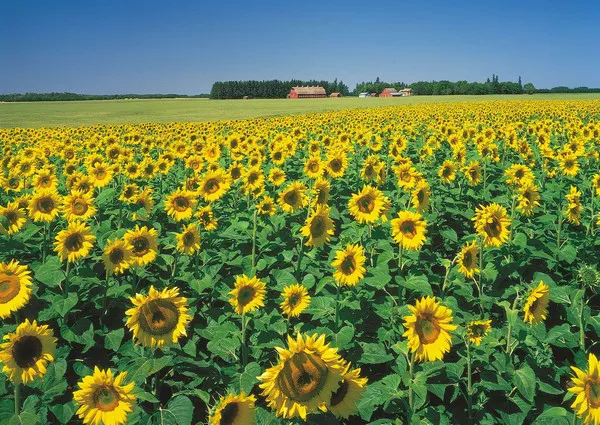The mammoth sunflower, with its towering height and impressive blooms, captivates gardeners and nature enthusiasts alike. Planting mammoth sunflower seeds is a rewarding endeavor that allows you to witness the remarkable growth of these iconic flowers.
Choosing Mammoth Sunflower Seeds
The first step in growing mammoth sunflowers is selecting high-quality seeds. Look for reputable seed suppliers or nurseries that offer mammoth sunflower varieties known for their impressive size. Mammoth sunflowers typically belong to the Helianthus annuus species, and there are several cultivars available, each with its unique characteristics. Choose seeds that are plump, undamaged, and ideally, from a reliable source to ensure successful germination.
Selecting the Planting Site
Mammoth sunflowers are known for their love of sunlight, so choose a planting site that receives full sun exposure. These sun-loving plants thrive in well-drained soil with good fertility. While mammoth sunflowers are adaptable to various soil types, they prefer loamy soil that retains moisture without becoming waterlogged. Ensure that the chosen location provides enough space for the towering growth of these giants without shading nearby plants.
Timing of Planting
Mammoth sunflowers are best planted directly in the garden after the last frost date has passed. Depending on your region, this is typically in late spring or early summer. These sunflowers have a relatively quick germination period, and planting them when the soil has warmed ensures optimal growth conditions. In regions with a longer growing season, successive plantings can be done to stagger bloom times and extend the flowering period.
Soil Preparation
Prepare the soil by loosening it to a depth of at least 12 inches. Incorporate organic matter, such as compost or well-rotted manure, to improve soil fertility and drainage. Mammoth sunflowers are not overly picky about soil conditions, but well-prepared soil sets the stage for healthy root development and robust growth. Avoid heavy clay soils that can become compacted, hindering root expansion.
Planting Mammoth Sunflower Seeds
Plant mammoth sunflower seeds directly in the garden soil, as they do not transplant well due to their deep root systems. Create shallow furrows in the soil, spaced about 2 feet apart, and sow the seeds at a depth of 1 to 1.5 inches. Space the seeds 6 to 12 inches apart within the rows. While mammoth sunflowers are known for their impressive size, providing ample spacing ensures each plant has sufficient room to develop a strong stem and expansive foliage.
Watering Considerations
Water the newly planted seeds thoroughly, ensuring that the soil is evenly moist. While mammoth sunflowers are relatively drought-tolerant once established, consistent moisture is crucial during the germination and early growth stages. Watering deeply and infrequently is preferable to shallow and frequent watering, as it encourages the development of deep, robust roots.
Mulching for Moisture Retention
Applying a layer of mulch around the base of the emerging sunflower seedlings helps retain soil moisture and suppress weed growth. Organic mulches, such as straw or wood chips, provide insulation to the soil and contribute to a more stable soil temperature. Mulching also reduces competition from weeds, allowing the mammoth sunflowers to thrive without unnecessary competition for resources.
Providing Support for Tall Stems
As mammoth sunflowers grow, they develop tall, sturdy stems that may require support to prevent toppling, especially in windy conditions. Consider placing stakes or installing a support structure around the sunflower plants when they reach a height of about 12 inches. This early support helps prevent stem breakage and ensures that the sunflowers grow upright, reaching their full height potential.
Fertilizing Mammoth Sunflowers
While mammoth sunflowers are not heavy feeders, they benefit from a balanced fertilizer application at the time of planting and once during the growing season. Use a fertilizer with a balanced ratio of nitrogen, phosphorus, and potassium to support overall plant health and encourage robust growth. Avoid excessive nitrogen, as it can lead to excessive foliage at the expense of flower development.
Monitoring for Pests and Diseases
Keep a watchful eye for common pests such as aphids, caterpillars, and birds, especially as the sunflowers begin to develop buds. Aphids can be gently washed off with a hose, and protective netting can deter birds from feasting on the flower heads. Mammoth sunflowers are generally resilient, but addressing pest issues promptly helps ensure the plants remain healthy and vibrant.
Deadheading and Pruning
Deadheading, or the removal of spent flowers, can prolong the blooming period of mammoth sunflowers. As each flower head fades, carefully snip it off to redirect the plant’s energy into developing new blooms. Additionally, pruning lower leaves that show signs of yellowing or disease helps improve air circulation and reduces the risk of fungal issues.
Harvesting Mammoth Sunflower Seeds
The grand finale of growing mammoth sunflowers is the harvest of their seeds. As the flower heads mature and the back of the flower turns from green to yellow, it’s time to harvest the seeds. Cut the entire flower head, leaving a portion of the stem attached. Hang the harvested flower heads upside down in a dry, well-ventilated area to allow the seeds to fully dry. Once dry, the seeds can be easily extracted for roasting, bird feeding, or saved for planting in the next season.
Conclusion
Growing mammoth sunflowers from seeds is a delightful journey that unfolds into towering beauty and vibrant blooms. By following these steps and considering the unique needs of these sun-loving giants, you can cultivate a garden spectacle that captures the essence of summer. From choosing the right seeds to providing the necessary care and support, the process of nurturing mammoth sunflowers is both rewarding and awe-inspiring. As these giants reach for the sky, they bring a touch of nature’s grandeur to your garden, creating a memorable and visually stunning display for all to enjoy.


